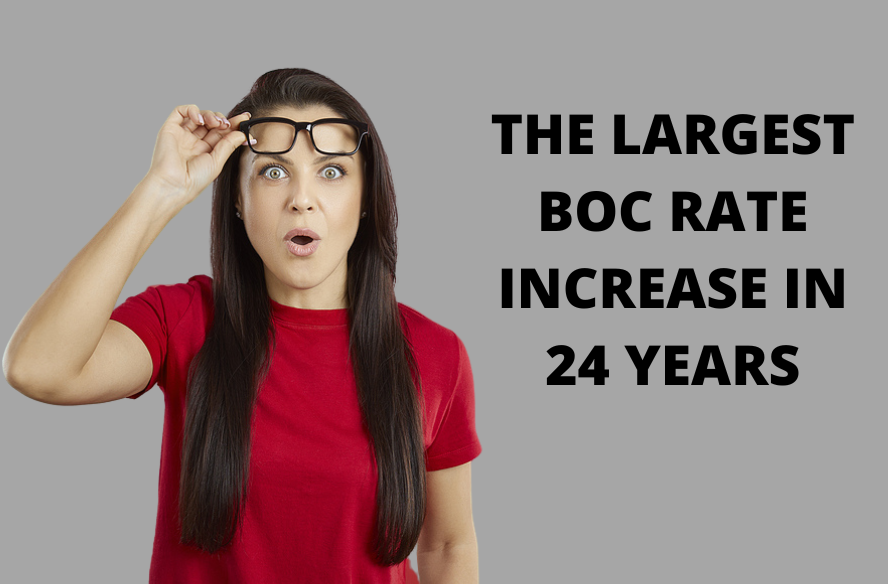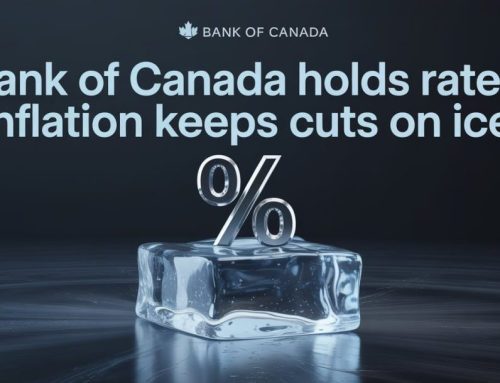It was widely anticipated that the Bank of Canada would increase its key policy rate by as much as 0.75% in this morning’s scheduled announcement. However, they shocked the market by taking it one step further and increased it by a full 1.00%.
This is the largest increase we have seen in a single announcement since 1998.
The new prime rate will move from 3.70% to 4.70%, which is 0.75% higher than it was before the pandemic started.
But why such a bold increase, and what does this mean for mortgage rates moving forward?
Why Such An Aggressive Increase?
Letting inflation run out of control is not an option for the Bank of Canada. It has now hit 7.7%, which is the highest it has been in 40 years. They have stated several times that they are prepared to act “aggressively” and do “whatever it takes” to bring it back down to a reasonable level.
This supersized rate increase is a prime example of what they were referring to.
The Bank of Canada has stated multiple times that inflation would be transitory, however this has proved to be very wrong. Inflation is now expected to be elevated for longer than originally anticipated, which means they are forced to increase their rate faster than expected. This morning’s announcement was clear evidence of that.
Does This Mean Prime Rate Will Increase More Than Expected?
The Bank of Canada is moving up their agenda by stacking increases sooner, rather than increasing them gradually over the next year. This doesn’t mean that they will increase more than originally expected. Economists from the big six banks have all predicted that we would see increases of another 1.25% to 1.75% over the next year. This includes the July 13th rate hike.
If the current predictions hold, this means we can expect increases of another 0.25% to 0.75% over the next year.
But will they hold?
I think another 0.25% might be a little overly optimistic. But it’s possible that they could stop with another 0.75%.
The question is, how fast will they move forward with the additional increases expected?
Time will tell and anything can happen. Either way, I would expect another increase from the BOC in their next scheduled announcement on September 7th. It’s just a matter of how large of an increase they feel will be necessary.
The BOC’s Agenda Will Lead To A New Problem
They Bank of Canada has never been more serious about handling inflation. The problem is closely tied to supply issues that were pandemic driven, and then further damaged by the war in Ukraine. The BOC’s intention with the large and rapid rate increases is cool the economy, which will then bring demand down to match the current supply.
The Bank of Canada’s inflation target is 3.00% in 2023 followed by its end goal of 2.00% in 2024. By this time, the economy would be feeling the full impact of the rate increases which will almost certainly force us into a recession.
This will become the new problem.
The Bank of Canada will then need to lower their rate to stimulate demand to bring the economy back to a healthy level.
As I’ve been saying in my blogs for a while now, the faster and more aggressive the Bank of Canada is with their rate increases, the sooner they will need to come through with cuts.
They WILL come through with rate cuts… it’s just a matter of when they start. But until inflation is brought under control, rates will remain elevated.
How The Rate Increase Affects Your Mortgage Payment
Fixed Rate
Anyone currently in a fixed rate mortgage will expect their rate and payment remain the same until the end of their term.
True Variable Rate:
Anyone in a true variable rate mortgage will not see any changes to their payment. What will change is the portion of the payment that is applied to principal vs. interest. When rates rise, the interest portion of the payment increases while the principal portion drops. As the principal portion is reduced, the amortization would be extended accordingly.
For anyone currently in a true variable rate mortgage, I would strongly recommend for you to use your prepayment privileges to increase your payments to keep your remaining amortization in check. Any additional payment made will be applied directly towards your principal, which will then reduce your effective amortization.
Adjustable Rate Mortgages
Most floating rate (variable) mortgages are adjustable, which means that your payment will change with rate. For every $100,000 you owe, the payment increase will be approximately $12.50 for each 0.25% in rate increase. A 1.00% increase in rate would then equal a payment increase of roughly $50 for each $100,000 owed. Note that the exact payment difference will vary marginally depending on your remaining amortization. You can read more about this in my blog on The Effect Of Prime Rate Increases On Your Payment
Conclusion
Yes, the Bank of Canada shocked us with their largest increase in 24 years. I don’t think anyone was expecting this… maybe not even the BOC themselves. They are not finished with their rate hikes which are expected to continue with their next scheduled rate announcement on September 7th.
No one likes to see rates increase this quickly, but we also don’t care much for rapid inflation.
How would you feel if gas prices went to $4.00 per liter?
Or if you had to pay $12 for a loaf of bread?
What about $75,000 for a base model Honda Civic?
This is what the Bank of Canada is trying to prevent.
Please leave a comment below!








Leave A Comment